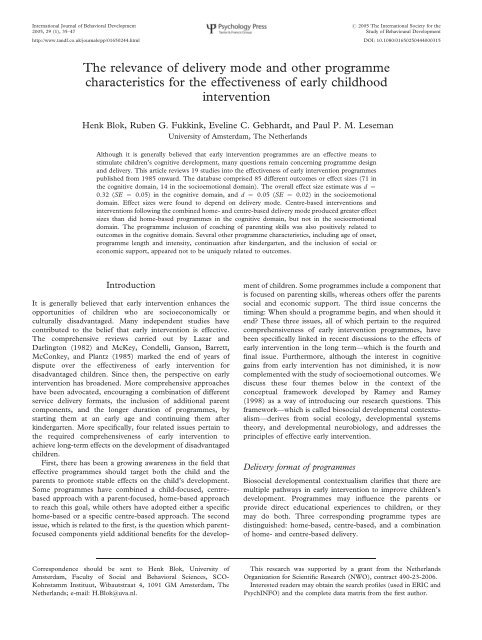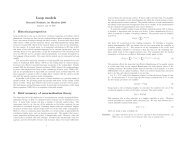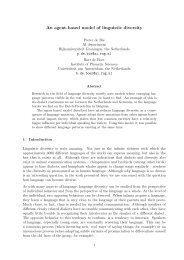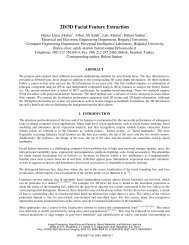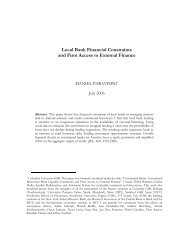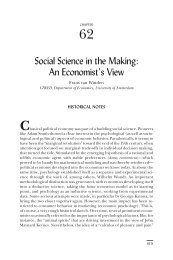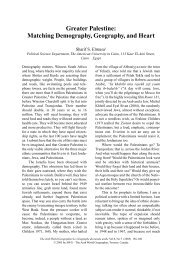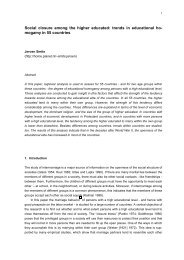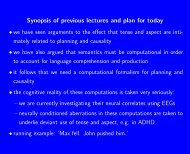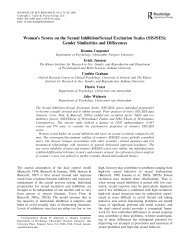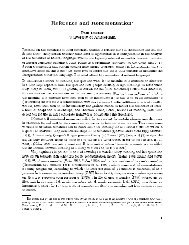The relevance of delivery mode and other programme ...
The relevance of delivery mode and other programme ...
The relevance of delivery mode and other programme ...
- No tags were found...
You also want an ePaper? Increase the reach of your titles
YUMPU automatically turns print PDFs into web optimized ePapers that Google loves.
International Journal <strong>of</strong> Behavioral Development# 2005 <strong>The</strong> International Society for the2005, 29 (1), 35–47 Study <strong>of</strong> Behavioural Developmenthttp://www.t<strong>and</strong>f.co.uk/journals/pp/01650244.html DOI: 10.1080/01650250444000315<strong>The</strong> <strong>relevance</strong> <strong>of</strong> <strong>delivery</strong> <strong>mode</strong> <strong>and</strong> <strong>other</strong> <strong>programme</strong>characteristics for the effectiveness <strong>of</strong> early childhoodinterventionHenk Blok, Ruben G. Fukkink, Eveline C. Gebhardt, <strong>and</strong> Paul P. M. LesemanUniversity <strong>of</strong> Amsterdam, <strong>The</strong> Netherl<strong>and</strong>sAlthough it is generally believed that early intervention <strong>programme</strong>s are an effective means tostimulate children’s cognitive development, many questions remain concerning <strong>programme</strong> design<strong>and</strong> <strong>delivery</strong>. This article reviews 19 studies into the effectiveness <strong>of</strong> early intervention <strong>programme</strong>spublished from 1985 onward. <strong>The</strong> database comprised 85 different outcomes or effect sizes (71 inthe cognitive domain, 14 in the socioemotional domain). <strong>The</strong> overall effect size estimate was d ¼0.32 (SE ¼ 0.05) in the cognitive domain, <strong>and</strong> d ¼ 0.05 (SE ¼ 0.02) in the socioemotionaldomain. Effect sizes were found to depend on <strong>delivery</strong> <strong>mode</strong>. Centre-based interventions <strong>and</strong>interventions following the combined home- <strong>and</strong> centre-based <strong>delivery</strong> <strong>mode</strong> produced greater effectsizes than did home-based <strong>programme</strong>s in the cognitive domain, but not in the socioemotionaldomain. <strong>The</strong> <strong>programme</strong> inclusion <strong>of</strong> coaching <strong>of</strong> parenting skills was also positively related tooutcomes in the cognitive domain. Several <strong>other</strong> <strong>programme</strong> characteristics, including age <strong>of</strong> onset,<strong>programme</strong> length <strong>and</strong> intensity, continuation after kindergarten, <strong>and</strong> the inclusion <strong>of</strong> social oreconomic support, appeared not to be uniquely related to outcomes.IntroductionIt is generally believed that early intervention enhances theopportunities <strong>of</strong> children who are socioeconomically orculturally disadvantaged. Many independent studies havecontributed to the belief that early intervention is effective.<strong>The</strong> comprehensive reviews carried out by Lazar <strong>and</strong>Darlington (1982) <strong>and</strong> McKey, Condelli, Ganson, Barrett,McConkey, <strong>and</strong> Plantz (1985) marked the end <strong>of</strong> years <strong>of</strong>dispute over the effectiveness <strong>of</strong> early intervention fordisadvantaged children. Since then, the perspective on earlyintervention has broadened. More comprehensive approacheshave been advocated, encouraging a combination <strong>of</strong> differentservice <strong>delivery</strong> formats, the inclusion <strong>of</strong> additional parentcomponents, <strong>and</strong> the longer duration <strong>of</strong> <strong>programme</strong>s, bystarting them at an early age <strong>and</strong> continuing them afterkindergarten. More specifically, four related issues pertain tothe required comprehensiveness <strong>of</strong> early intervention toachieve long-term effects on the development <strong>of</strong> disadvantagedchildren.First, there has been a growing awareness in the field thateffective <strong>programme</strong>s should target both the child <strong>and</strong> theparents to promote stable effects on the child’s development.Some <strong>programme</strong>s have combined a child-focused, centrebasedapproach with a parent-focused, home-based approachto reach this goal, while <strong>other</strong>s have adopted either a specifichome-based or a specific centre-based approach. <strong>The</strong> secondissue, which is related to the first, is the question which parentfocusedcomponents yield additional benefits for the development<strong>of</strong> children. Some <strong>programme</strong>s include a component thatis focused on parenting skills, whereas <strong>other</strong>s <strong>of</strong>fer the parentssocial <strong>and</strong> economic support. <strong>The</strong> third issue concerns thetiming: When should a <strong>programme</strong> begin, <strong>and</strong> when should itend? <strong>The</strong>se three issues, all <strong>of</strong> which pertain to the requiredcomprehensiveness <strong>of</strong> early intervention <strong>programme</strong>s, havebeen specifically linked in recent discussions to the effects <strong>of</strong>early intervention in the long term—which is the fourth <strong>and</strong>final issue. Furthermore, although the interest in cognitivegains from early intervention has not diminished, it is nowcomplemented with the study <strong>of</strong> socioemotional outcomes. Wediscuss these four themes below in the context <strong>of</strong> theconceptual framework developed by Ramey <strong>and</strong> Ramey(1998) as a way <strong>of</strong> introducing our research questions. Thisframework—which is called biosocial developmental contextualism—derivesfrom social ecology, developmental systemstheory, <strong>and</strong> developmental neurobiology, <strong>and</strong> addresses theprinciples <strong>of</strong> effective early intervention.Delivery format <strong>of</strong> <strong>programme</strong>sBiosocial developmental contextualism clarifies that there aremultiple pathways in early intervention to improve children’sdevelopment. Programmes may influence the parents orprovide direct educational experiences to children, or theymay do both. Three corresponding <strong>programme</strong> types aredistinguished: home-based, centre-based, <strong>and</strong> a combination<strong>of</strong> home- <strong>and</strong> centre-based <strong>delivery</strong>.Correspondence should be sent to Henk Blok, University <strong>of</strong>Amsterdam, Faculty <strong>of</strong> Social <strong>and</strong> Behavioral Sciences, SCO-Kohnstamm Instituut, Wibautstraat 4, 1091 GM Amsterdam, <strong>The</strong>Netherl<strong>and</strong>s; e-mail: H.Blok@uva.nl.This research was supported by a grant from the Netherl<strong>and</strong>sOrganization for Scientific Research (NWO), contract 490-23-2006.Interested readers may obtain the search pr<strong>of</strong>iles (used in ERIC <strong>and</strong>PsychINFO) <strong>and</strong> the complete data matrix from the first author.
36 BLOK ET AL. / EFFECTIVENESS OF EARLY CHILDHOOD EDUCATIONHome-based interventions rely on an indirect way <strong>of</strong>stimulating children’s development (e.g., through parenttraining). A common starting point <strong>of</strong> home-based <strong>programme</strong>sis the belief that the parents <strong>of</strong> disadvantagedchildren use less effective parenting strategies because theylack the necessary knowledge (Goodson, Layer, StPierre,Bernstein, & Lopez, 2000). It is hypothesised that home-based<strong>programme</strong>s lead to a change in parental attitudes, behaviour,<strong>and</strong> school involvement. This results in more <strong>and</strong> higherqualityparent–child transactions <strong>and</strong> family-orchestrated childexperiences (Guralnick, 1998), <strong>and</strong> these have positive effectson the child. However, reviews <strong>of</strong> the available evidence for theeffects <strong>of</strong> home-based <strong>programme</strong>s are not too optimistic(Gomby, Culross, & Behrman, 1999). Parenting interventionalone is viewed as too weak, because parenting beliefs <strong>and</strong>practices cannot be altered easily (Halpern, 2000). Otherauthors have concluded that although home-based <strong>programme</strong>scan affect parental attitudes <strong>and</strong> behaviour, such<strong>programme</strong>s do not result in positive child outcomes (Farran,2000).Centre-based <strong>programme</strong>s provide children with directeducational experiences, for instance in a daycare or preschoolsetting. Findings in this field have shown that significant effectscan be achieved for developmental competence <strong>and</strong> achievementtests at the end <strong>of</strong> preschool <strong>and</strong> into kindergarten. <strong>The</strong>reis growing evidence that direct provision in centre-basedapproaches is more effective than indirect provision in homebasedapproaches (Barnett, 1995; Bowerman, Donovan, &Burns, 2001; Farran, 2000; McGuire & Earls, 1991; Ramey &Ramey, 1998). Ramey <strong>and</strong> Ramey clearly favour a centrebasedapproach, as they are convinced that the direct provision<strong>of</strong> learning experiences leads to larger <strong>and</strong> more enduringbenefits than does indirect provision (e.g., parent training).Several <strong>programme</strong>s <strong>of</strong>fer a combination <strong>of</strong> home-based <strong>and</strong>centre-based components. Combining the two <strong>delivery</strong> formatsmay create more pathways for positive change in families’ lives<strong>and</strong> have synergetic effects (Smith & Zaslow, 1995). Surprisingly,however, the seemingly widely shared preference for acombined approach is not unequivocally supported by reviews.While in their narrative reviews Barnett (1995) <strong>and</strong> Farran(2000) favour a combined approach, White, Taylor, <strong>and</strong> Moss(1992) found no convincing evidence that the involvement <strong>of</strong>parents results in more effective outcomes. White et al.reviewed eight studies <strong>of</strong> disadvantaged children in which thedegree <strong>of</strong> parental involvement represents the only differencebetween the experimental groups. <strong>The</strong> average effect size for allstudies across all child measures was 0.11 <strong>of</strong> a st<strong>and</strong>arddeviation, with the best designed studies arriving at the weakestresults. To conclude, there are still unanswered questionsconcerning the effectiveness <strong>of</strong> these service <strong>delivery</strong> <strong>mode</strong>ls, asnoted by Campbell <strong>and</strong> Ramey (1995, p. 745).Programme comprehensivenessBiosocial developmental contextualism promotes a moreinclusive view <strong>of</strong> early intervention (Ramey & Ramey, 1998).<strong>The</strong> field <strong>of</strong> early intervention has moved on from a specificfocus on the deficits <strong>of</strong> the child to, in more recent<strong>programme</strong>s, a focus on both child <strong>and</strong> family. Many <strong>of</strong> these<strong>programme</strong>s include a component that focuses on the coaching<strong>of</strong> parenting skills. Other <strong>programme</strong>s also <strong>of</strong>fer the parentssocial <strong>and</strong> economic support. <strong>The</strong> promotion <strong>of</strong> childdevelopment, the enhancement <strong>of</strong> parenting skills, <strong>and</strong> theprovision <strong>of</strong> adult services can also be combined in a threeprongedapproach.A principal issue is which goals deserve primary attention inearly intervention. Reynolds (1998), for example, argues that‘‘although there is consensus about the importance <strong>of</strong>providing comprehensive services, there is less consensusabout the relative importance <strong>of</strong> these services <strong>and</strong> the extentto which these services should be provided’’ (p. 508). Forexample, it can be hypothesised that the coaching <strong>of</strong> parentingskills, which can be conceived as an indirect but targetedapproach to stimulate the development <strong>of</strong> children, is morebeneficial to children than adult economic or social support,which is primarily focused on the parents. Furthermore, it is anopen question whether interventions that are theoreticallypowerful are also more effective in practice (Gomby, Larner,Stevenson, Lewit, & Behrman, 1995).Timing <strong>and</strong> duration <strong>of</strong> <strong>programme</strong>sResearch in developmental neurobiology has recently underlinedthe importance <strong>of</strong> very early stimulation. It is becomingincreasingly clear that neurodevelopment is for a large partexperience-driven, <strong>and</strong> that brain development depends onearly experiences (Shore, 1997). This motivates an early start<strong>of</strong> interventions that aim at the improved development <strong>of</strong>disadvantaged children.Halpern (2000) has stressed that intervention should notonly start early, but also be continuous in order to be effectivein the long run. Farran (2000) <strong>and</strong> Rimm-Kaufman <strong>and</strong> Pianta(2000) specifically emphasised the importance <strong>of</strong> the transitionfrom kindergarten to primary school, which evokes the need forcontinued support. According to Reynolds (1998), earlyintervention should be continued into second or third gradein order to promote long-term effectiveness.Retention <strong>of</strong> effects<strong>The</strong> above-mentioned issues <strong>of</strong> multiple combined formats,the inclusion <strong>of</strong> additional components, <strong>and</strong> the timing <strong>and</strong>duration <strong>of</strong> <strong>programme</strong>s have been specifically discussed in thecontext <strong>of</strong> the long-term effectiveness <strong>of</strong> early intervention(Barnett, 1995; Gomby et al., 1995; Reynolds, 1998).Basically, there are two hypotheses concerning the outcome<strong>of</strong> early intervention. <strong>The</strong> first predicts that the immediateeffects are sustained. <strong>The</strong> cognitive advantage hypothesis, forinstance, predicts that early intervention ‘‘initiates a positivecycle <strong>of</strong> scholastic development <strong>and</strong> commitment that culminatesin improved developmental outcomes in adolescence <strong>and</strong>beyond’’ (Reynolds, Mavrogenes, Bezruczko & Hagemann,1996, p. 1119). However, the second, rival hypothesis predictsthat effects fade over time. Farran (2000), for example,emphasised that most <strong>programme</strong>s focus on concrete skillsrelated to readiness tests, whereas pr<strong>of</strong>ound curricular changestake place in third <strong>and</strong> fourth grade. Several evaluations haveindeed shown a fading <strong>of</strong> the positive results (Blok & Leseman,1996; McKey et al., 1985). Significant effects <strong>of</strong> centre-based<strong>programme</strong>s, for example, are rare by—<strong>and</strong> nonexistentbeyond—first grade, according to Farran (2000) <strong>and</strong> Gilliam<strong>and</strong> Zigler (2000). <strong>The</strong> increasing number <strong>of</strong> studies <strong>and</strong> thelonger span <strong>of</strong> follow-up studies enable not only a moreprecise, but also a more general estimate <strong>of</strong> the retention <strong>of</strong><strong>programme</strong> effects in the long run.
INTERNATIONAL JOURNAL OF BEHAVIORAL DEVELOPMENT, 2005, 29 (1), 35–47 37Goal <strong>of</strong> the study<strong>The</strong> goal <strong>of</strong> the study was to answer questions regarding the<strong>delivery</strong> <strong>and</strong> design <strong>of</strong> early intervention <strong>programme</strong>s fordisadvantaged children. <strong>The</strong> inclusion <strong>of</strong> additional <strong>programme</strong>components, <strong>and</strong> the timing, duration, <strong>and</strong> intensity<strong>of</strong> <strong>programme</strong>s were among the design features. We also paidattention to the recency <strong>of</strong> <strong>programme</strong>s. Finally, we distinguishedbetween the immediate effects <strong>of</strong> the <strong>programme</strong> <strong>and</strong>their retention. Effectiveness is defined at the child level,distinguishing between cognitive <strong>and</strong> socioemotional effects.To answer these questions, we conducted a meta-analysis <strong>of</strong>the outcomes published from 1985 onward. We decided torestrict ourselves to this year <strong>of</strong> publication because manyearlier results had already been reviewed (in, e.g., Lazar &Darlington, 1982; McKey et al., 1985; White et al., 1992).MethodSelecting the studiesWe searched ERIC <strong>and</strong> PsychINFO—the major databases inthe fields <strong>of</strong> education <strong>and</strong> child development—combiningthree groups <strong>of</strong> descriptors: one to indicate the independentvariables (e.g., <strong>programme</strong> evaluation, curriculum evaluation,course evaluation, home <strong>programme</strong>s, parent training, daycare),one to indicate the dependent variables (e.g., outcomes<strong>of</strong> education, basic skills, academic achievement, cognitivedevelopment), <strong>and</strong> one to indicate the age <strong>of</strong> the students (e.g.,early childhood education, preschool education, kindergarten,toddler). We thus focused explicitly on <strong>programme</strong>s with aneducational orientation, excluding <strong>programme</strong>s oriented solelytoward socioemotional development or child health. We alsoexcluded studies <strong>of</strong> gifted children <strong>and</strong> <strong>of</strong> children who are atrisk for medical reasons (e.g., premature birth, h<strong>and</strong>icapped,impaired, retarded, disabled). All selected studies appeared t<strong>of</strong>ocus on disadvantaged children.<strong>The</strong> references <strong>of</strong> collected papers <strong>and</strong> articles weresearched for additional references. Additionally, relevantstudies were suggested by experts. We deliberately restrictedour search to articles published in peer-reviewed journals. <strong>The</strong>rationale was that limiting studies to those passing the test <strong>of</strong>peer review minimises the risk <strong>of</strong> admitting studies <strong>of</strong> poorquality. For the same reason, studies had to include anontreated control group in order to qualify for our analysis.Our final set comprised 19 studies, which were subsequentlysubjected to the review procedure.Deciding on the relevant comparisons<strong>The</strong>re was not always a simple one-to-one correspondencebetween studies <strong>and</strong> experimental comparisons, namelycomparisons between an experimental <strong>and</strong> a control group.Some studies reported the effects <strong>of</strong> more than one experimentalcondition, while <strong>other</strong>s evaluated essentially the sameexperimental condition in more than one sample. On the <strong>other</strong>h<strong>and</strong>, one <strong>and</strong> the same experimental comparison wasdifferentially conceived <strong>of</strong> in different publications, for instancewhen one article reported on the full sample, <strong>and</strong> a subsequentarticle—evaluating follow-up results—reported on only asubsample <strong>of</strong> the original sample. We therefore decided toadopt the level <strong>of</strong> the experimental comparison as the unit <strong>of</strong>coding.Relatively straightforward decisions could be taken forseveral studies, whereas decisions were more complicated inthe case <strong>of</strong> <strong>other</strong>s. Kagitcibasi, Sunar, <strong>and</strong> Bekman (2001)reported effects <strong>of</strong> the Turkish Early Enrichment Project—anadaptation <strong>of</strong> the Hippy (Home Instruction Program forPreschool Youngsters) <strong>programme</strong>, which was originallydeveloped in Israel (Lombard, 1981). <strong>The</strong>y complemented itwith a m<strong>other</strong> training component. <strong>The</strong>ir study was a 3 2 2 factorial design with three categories <strong>of</strong> early childhood care(preschool, daycare, homecare), two levels <strong>of</strong> home intervention(Hippy, no Hippy), <strong>and</strong> two age levels (3 <strong>and</strong> 5 years atthe beginning <strong>of</strong> the study). Because the number <strong>of</strong> students inthe different cells was rather low, we decided to aggregate thedata by age levels. Furthermore, we considered the Hippy/noHippy factor as our main factor <strong>of</strong> interest. Accordingly, thestudy allowed us to make three comparisons, namely the effect<strong>of</strong> Hippy/no Hippy in three early childhood care arrangements:preschool, daycare, <strong>and</strong> homecare.<strong>The</strong> results <strong>of</strong> generic Head Start <strong>programme</strong>s have beenreported by Lee, Brooks-Gunn, <strong>and</strong> Schnur (1988) <strong>and</strong> Lee,Brooks-Gunn, Schnur, <strong>and</strong> Liaw (1990). In both articles,participation in Head Start was compared to either nopreschool or <strong>other</strong> preschool experiences, allowing twocomparisons (Head Start vs. no preschool, <strong>and</strong> Head Startvs. <strong>other</strong> preschool). <strong>The</strong> first article provided data frompretests <strong>and</strong> posttests, the latter administered immediatelyafter the end <strong>of</strong> the intervention. <strong>The</strong> second article reportedno pretest results, but only posttests results 1 <strong>and</strong> 2 years afterthe end <strong>of</strong> the Head Start intervention. Although the samplesoverlapped considerably, they were not identical: <strong>The</strong> sampledealt with in the follow-up article was 33% smaller (the HeadStart group had shrunk from 414 to 333, the no-preschoolgroup from 390 to 204, <strong>and</strong> the <strong>other</strong> preschool group from165 to 109), excluding all non-black children. We decided tocombine the results <strong>of</strong> both articles, noting that the results <strong>of</strong>the follow-up measures might be biased.Madden, Slavin, Karweit, Dolan, <strong>and</strong> Wasik (1993) <strong>and</strong>Slavin, Madden, Karweit, Livermon, <strong>and</strong> Dolan (1990)reported outcomes <strong>of</strong> Success for All (SFA), an intervention<strong>programme</strong> starting in preschool <strong>and</strong> continuing into Grade 3.Slavin et al. described the first year <strong>of</strong> SFA (1987/1988), <strong>and</strong>reported outcomes for five samples (preschool, kindergarten,Grade 1, Grade 2, Grade 3). Only the first two samples wererelevant to our review, as the <strong>other</strong> samples had received noearly intervention. <strong>The</strong> results reported in Madden et al.concerned outcomes from the third year <strong>of</strong> SFA (1990/1991),by which time the <strong>programme</strong> was running in five differentschools. Some <strong>of</strong> these outcomes (collected at the Abbottstonschool) were regarded as follow-up results for the students inthe 1987/1988 sample. Other outcomes reflected independentdata gathered from <strong>other</strong> schools. We extracted four comparisonsfrom the two articles: two concerning Abbottston data(including follow-up results in 1990/1991) <strong>and</strong> two reflectingGrade 1 (evaluating the effect <strong>of</strong> preschool <strong>and</strong> kindergartenintervention, aggregated by school) <strong>and</strong> Grade 2 (evaluatingthe effect <strong>of</strong> kindergarten only, also aggregated by school, butexcluding Abbottston), respectively. <strong>The</strong>se comparisons weredefined in this way to avoid an overlap in the sample <strong>of</strong>students.<strong>The</strong> outcomes <strong>of</strong> the Abecedarian project have beenreported in many journal articles, beginning with Burchinal,Lee <strong>and</strong> Ramey (1989). <strong>The</strong> research design changed in thecourse <strong>of</strong> the project, <strong>and</strong> finally consisted <strong>of</strong> three experi-
38 BLOK ET AL. / EFFECTIVENESS OF EARLY CHILDHOOD EDUCATIONmental conditions <strong>and</strong> one control condition. Two experimentalcomparisons were within the domain <strong>of</strong> our researchquestion. One was that between the CC (control condition,i.e., no preschool, no follow-up <strong>programme</strong>) <strong>and</strong> the EEcondition, in which students received preschool education forthe first 5 years <strong>of</strong> their life, followed by a supplementaryEducational Support Program from kindergarten through 2ndgrade. <strong>The</strong> second comparison we extracted from the availabledata was that between the CC condition <strong>and</strong> the EC condition,in which students received only the preschool <strong>programme</strong> <strong>and</strong>not the follow-up <strong>programme</strong>. <strong>The</strong> data we used came fromRamey, Campbell, Burchinal, Skinner, Gardner, <strong>and</strong> Ramey(2000), who presented IQ data from 5 to 15 years old, <strong>and</strong>school performance data from 8 to 15 years old.<strong>The</strong> results <strong>of</strong> the Chicago Child-Parent Center <strong>and</strong>Expansion Program (CPC&EP) have also been widelyrepresented in the research literature. We selected the outcomesreported in Reynolds (1994) as our reference data,because the presented intervention groups were the mostrelevant to our research question. We extracted one experimentalcomparison from these data, namely the full interventiongroup with follow-on (denoted as PS þ KG þ PG-3 byReynolds) with the non-CPC comparison group.We found two studies on the effectiveness <strong>of</strong> a supplementaryemergent literacy curriculum compared to a st<strong>and</strong>ardHead Start <strong>programme</strong> (Whitehurst, Epstein, Angell, Payne,Crone, & Fishel, 1994; Whitehurst, Zevenbergen, Crone,Schultz, & Velting, 1999). <strong>The</strong> second study is a replication <strong>of</strong>the first, <strong>and</strong> includes a follow-up <strong>of</strong> both the original cohort<strong>and</strong> the replication cohort. Unfortunately, the outcomes <strong>of</strong> thetwo studies were not reported independently, as the secondarticle (Whitehurst et al., 1999) combined the results <strong>of</strong> bothcohorts. This left us no choice but to use the outcomes <strong>of</strong> thesecond article only, as it concerned the biggest sample <strong>and</strong>provided follow-up results. <strong>The</strong> two Whitehurst et al. studiestherefore resulted in one experimental comparison, namelyHead Start with an emergent literacy add-on contrasted with aHead Start-only condition.After all decisions had been made, there remained 34experimental comparisons.Coding <strong>of</strong> variables<strong>The</strong> experimental comparisons in the database were coded forseveral characteristics (see Table 1). Variables 1–3 concerndesign characteristics, variables 4–11 concern sample characteristics,<strong>and</strong> variables 12–17 concern characteristics <strong>of</strong> theexperimental intervention.Because most experimental comparisons resulted in multipleoutcomes, <strong>other</strong> variables (variables 18–25) were coded atTable 1Coding scheme for the experimental comparisons, <strong>and</strong> reliability <strong>of</strong> codingInter-coderVariable Scale reliability a1. Subject assignment 0. Strictly controlled (r<strong>and</strong>omisation or matching at subject level); 1. no strict control 87(r<strong>and</strong>omisation or matching at group level, post hoc comparison, or no control at all)2. Treatment fidelity 0. High in most respects; 1. unknown 1003. Intervention in control group 0. St<strong>and</strong>ard <strong>programme</strong>, not under control <strong>of</strong> experimenter; 1. unknown <strong>programme</strong> 92or no <strong>programme</strong> at all4. Nation 0. USA; 1. <strong>other</strong> than USA 1005. Recency <strong>of</strong> <strong>programme</strong>Numerical (minus 1900).93 b(year implementation started)6. Size <strong>of</strong> experimental group Number <strong>of</strong> students 1.00 b7. Size <strong>of</strong> control group Number <strong>of</strong> students .99 b8. Mean age <strong>of</strong> students at onset <strong>of</strong> study Number <strong>of</strong> months (before birth coded as 0) .96 b9. Percentage <strong>of</strong> students from ethnic Percentage.96 bminorities10. Level <strong>of</strong> education <strong>of</strong> parents 1. Low; 2. mixed; 9. unknown 8711. Level <strong>of</strong> income <strong>of</strong> parents 1. Low; 2. mixed; 9. unknown 9312. Delivery <strong>mode</strong> 1. Home-based; 2. centre-based; 3. combination <strong>of</strong> home- <strong>and</strong> centre-based 9613. Length <strong>of</strong> <strong>programme</strong> Number <strong>of</strong> months (a year equals 10 months, unless <strong>other</strong>wise indicated by.99 bexperimenter)14. Intensity <strong>of</strong> <strong>programme</strong> Number <strong>of</strong> hours per week .91 b15. Continuation after K 0. No; 1. yes 10016. Inclusion <strong>of</strong> social or economical 0. No; 1. yes 85support17. Inclusion <strong>of</strong> coaching <strong>of</strong> parenting skills 0. No; 1. yes 8518. Effect size at pretest Numerical 1.00 b19. St<strong>and</strong>ard error <strong>of</strong> pretest effect size Numerical .94 b20. Domain <strong>of</strong> the posttest 0. Cognition 1. socioemotional development 9321. Time <strong>of</strong> measurement <strong>of</strong> posttest Number <strong>of</strong> months after intervention ended, coded on a time scale <strong>of</strong> years 1.00 b22. Type <strong>of</strong> posttest score 0. Observed score; 1. gain score or score adjusted for covariates 9423. Type <strong>of</strong> posttest effect size 0. Derived by reviewers; 1. reported by experimenters 10024. Effect size at posttest Numerical 1.00 b25. St<strong>and</strong>ard error <strong>of</strong> posttest effect size Numerical .94 ba Percentage <strong>of</strong> classifications agreed upon by the two coders, unless <strong>other</strong>wise indicated.b Product–moment correlation between the codes <strong>of</strong> the two coders.
INTERNATIONAL JOURNAL OF BEHAVIORAL DEVELOPMENT, 2005, 29 (1), 35–47 39the level <strong>of</strong> effect sizes. Hedges’ unbiased estimate d was usedas an effect size estimate (variables 18 <strong>and</strong> 24). This statisticuses the within-group st<strong>and</strong>ard deviation as a method <strong>of</strong>st<strong>and</strong>ardisation. It includes a correction factor to obviate biasresulting from small samples. <strong>The</strong> st<strong>and</strong>ard error <strong>of</strong> the effectsize (variables 19 <strong>and</strong> 25) was estimated following Hedges <strong>and</strong>Olkin (1985, p. 86, Eq. 15). Whenever possible, we usedobserved scores to calculate effect sizes. Several experimenters,however, reported only gain scores or scores adjusted forcovariates, indicated by variable 22 (type <strong>of</strong> posttest score).Some reported outcomes were inherently negative, forinstance when behaviour ratings referred to negative behaviour.In these cases, outcomes were recoded simply bychanging the sign. This correction procedure was applied tothe studies by Goodson et al. (2000), Johnson <strong>and</strong> Walker(1987), Scarr <strong>and</strong> McCartney (1988), <strong>and</strong> Seitz, Rosenbaum,<strong>and</strong> Apfel (1985).Two independent coders coded all the studies. Inter-coderreliability was estimated by determining the rate <strong>of</strong> agreementin the case <strong>of</strong> a nominal scale, or the product–momentcorrelation in the case <strong>of</strong> an interval scale. <strong>The</strong> results arereported in the last column <strong>of</strong> Table 1. <strong>The</strong> reliability provedto be satisfactory, ranging between 85 <strong>and</strong> 100% for nominalvariables, <strong>and</strong> between .91 <strong>and</strong> 1.00 for interval variables. Inthe case <strong>of</strong> divergent codes, final codes were established bymutual agreement, <strong>and</strong> used in subsequent analyses.Many study designs either did not incorporate a pretest ordid not report sufficient statistics to estimate an effect size thatcaptured the initial differences between conditions at thepretest. We were able to determine pretest effect sizes for only40% <strong>of</strong> our cases. To prevent an excessive loss <strong>of</strong> data, wedecided to impute zero scores for missing effect sizes atpretesting. This value is close to the mean value we found forcases, which allowed us to estimate a pretest effect size (meanvalue 0.06 with a corresponding st<strong>and</strong>ard error <strong>of</strong> 0.04).Integration <strong>of</strong> effects<strong>The</strong> coding phase resulted in a file containing 207 differentoutcomes (171 in the cognitive domain, 36 in the socioemotionaldomain) from the 34 experimental comparisons. Weanalysed the data in two steps. We first aggregated effect sizesto the level <strong>of</strong> the experimental comparisons. This aggregationwas performed separately for each domain <strong>and</strong> time <strong>of</strong>measurement, varying from 0 to 180 months after theintervention ended. This aggregation was conducted byweighted integration, in which the results were weighted ininverse proportion to their st<strong>and</strong>ard error (i.e., the greater thest<strong>and</strong>ard error, the smaller the weight). <strong>The</strong> aggregated effectsizes <strong>and</strong> the corresponding st<strong>and</strong>ard errors were estimatedfollowing Hedges <strong>and</strong> Olkin (1985, p. 112, Eqs. 8 <strong>and</strong> 9). Thisaggregation <strong>mode</strong>l assumes the results within one study to behomogeneous <strong>and</strong> to differ from each <strong>other</strong> only on the basis <strong>of</strong>r<strong>and</strong>om differences between the outcome variables. <strong>The</strong>st<strong>and</strong>ard errors <strong>of</strong> aggregated effect sizes are generally smallerthan the st<strong>and</strong>ard errors corresponding to the constituent effectsizes, which seems a fair reward for using more than oneoutcome measure. All calculations on aggregations were doneusing the Meta <strong>programme</strong> (Schwarzer, 1989). This first stepresulted in 85 different outcomes (71 in the cognitive domain,14 in the socioemotional domain).As a second step, outcomes or effect sizes were integratedinto an overall effect size, separately for each domain. <strong>The</strong>integration was performed according to the r<strong>and</strong>om effects<strong>mode</strong>l (Hedges & Olkin, 1985). <strong>The</strong> <strong>mode</strong>l we specifiedacknowledges the hierarchical <strong>and</strong> longitudinal nature <strong>of</strong> ourdata. <strong>The</strong> <strong>mode</strong>l splits the effect size d ijt for experimentalcomparison j from study i at moment t into two components,namely a true effect size d ijt , <strong>and</strong> an error component e ijt . <strong>The</strong>true effect sizes are assumed to vary across measurementmoments t, comparisons j, <strong>and</strong> studies i. <strong>The</strong> variance <strong>of</strong> d ijt isexplained by the regression <strong>mode</strong>l:d ijt ¼ g 0 þ g n Z nijt þ u ijt þ v ij þ w i (1)where g 0 is the gr<strong>and</strong> mean, Z nijt are characteristics <strong>of</strong> thestudies (n being the index referring to the characteristics),comparisons <strong>and</strong> measurement moments, <strong>and</strong> u ijt ,v ij , <strong>and</strong> w iare residual error terms at the three levels distinguished. <strong>The</strong><strong>mode</strong>l makes it possible to distinguish between three variancecomponents, viz. s 2u (the variance between measurementmoments t), s 2 v (the variance between experimental comparisonsj ), <strong>and</strong> s 2 w (the variance between studies i ). <strong>The</strong> <strong>mode</strong>lalso enables testing whether any <strong>of</strong> the parameter variances aresignificantly different from zero with the test statistic Q. Ifstudy outcomes are heterogeneous, it is worthwhile trying torelate the heterogeneity to the various characteristics Z nijt .Ifnot, the study outcomes are homogeneous <strong>and</strong> no explanatoryvariables need to be introduced in equation (1). <strong>The</strong>specification <strong>and</strong> testing <strong>of</strong> <strong>mode</strong>ls was carried out withMLwiN, using restricted maximum likelihood estimation(Goldstein et al., 1998; Hox, 2002). Analyses were performedseparately for both domains (cognition, socioemotional development).ResultsDescription <strong>of</strong> the studies in the databaseThis subsection briefly describes the studies in our database,which yielded 34 different comparisons (Table 2).Assignment <strong>of</strong> the subjects to the different conditions <strong>of</strong> thecomparison proceeded according to strict guidelines (atr<strong>and</strong>om, by matching, or by blocking) in only 16 cases. In<strong>other</strong> cases, less strict procedures were followed (e.g., r<strong>and</strong>omassignment or matching <strong>of</strong> intact groups), or assignment wasnot under the control <strong>of</strong> the investigator.Treatment fidelity was reported to be high in all or mostrespects for 11 <strong>of</strong> the 34 comparisons. For the <strong>other</strong>comparisons, no information could be found. However, thisdoes not necessarily mean that the treatment was jeopardised.We found the same lack <strong>of</strong> information with respect to thecontrol condition. Students in the control condition mostlyfollowed a ‘‘st<strong>and</strong>ard <strong>programme</strong>’’.<strong>The</strong> sample size was generally small, averaging 77 for boththe experimental <strong>and</strong> the control conditions. This averageexcludes the outlying large sample size <strong>of</strong> the study byGoodson et al. (2000), which featured about 1600 childrenin both conditions. <strong>The</strong> experimental group contained morethan 100 students in only 8 <strong>of</strong> the 34 comparisons. Evidently,such small sample sizes imply generally low power to detect adifference in outcomes. Most students belonged to an ethnicminority group (average: 81%, taking experimental <strong>and</strong> controlgroups together). Median student age at the start <strong>of</strong> theintervention <strong>programme</strong> showed considerable variation, rangingfrom pre-birth to 64 months (average 37 months). Boththe socioeconomic status <strong>and</strong> the income <strong>of</strong> parents were
40 BLOK ET AL. / EFFECTIVENESS OF EARLY CHILDHOOD EDUCATIONTable 2Summary <strong>of</strong> characteristics <strong>of</strong> the studies in the meta-analysisVariablesReferences Experimental comparisons 1 2 3 4 5 6 7 8 9 10 11 12 13 14 15 16 17Baker et al., 1998. Cohort I (Hippy vs. Control) 0 0 1 0 90 37 32 58 80 1 1 1 14 2 0 0 1Cohort II (Hippy vs. Control) 0 0 1 0 91 47 66 54 75 1 1 1 20 2 0 0 1Gersten et al., 1988. Direct instruction (K-3) vs.1 1 0 0 70 54 121 64 83 9 1 2 40 9 1 0 1ComparisonGoodson et al., 2000. Comprehensive Child Development 0 0 0 0 90 1640 1560 18 74 1 1 1 33 1 0 1 1Program vs. ControlHowell et al., 1990. Peabody LDK-R vs. Control 1 1 0 0 88 19 19 55 98 1 1 2 6 4 0 0 0Boehm RG vs. Control 1 1 0 0 88 19 19 55 98 1 1 2 6 4 0 0 0Bracken CDP vs. Control 1 1 0 0 88 19 19 55 98 1 1 2 6 4 0 0 0Johnson & Walker, 1987, Houston Parent–Child Development 0 1 1 0 75 51 88 12 100 1 1 3 20 7 0 0 11991; Walker & Johnson,1988.Program vs. ControlKagitcibasi et al., 2001. Education daycare (ED) with m<strong>other</strong> 0 0 0 1 85 27 37 48 0 1 1 1 14 2 0 0 1training (MT) vs. ED without MTCustodial daycare (CD) with m<strong>other</strong> 0 0 0 1 85 40 65 48 0 1 1 1 14 2 0 0 1training (MT) vs. CD without MTHome care (HC) with (MT) vs. HC 0 0 1 1 85 23 63 48 0 1 1 1 14 2 0 0 1without MTLee et al., 1988; 1990. Head Start vs. No preschool 1 1 1 0 69 333 204 50 100 1 1 2 9 20 0 0 0Head Start vs. Other preschool 1 1 0 0 69 333 109 50 100 1 1 2 9 20 0 0 0Olds et al., 1994; Treatment 3 vs. Treatment (1 þ 2) 0 0 1 0 77 78 148 0 0 1 1 1 4 1 0 0 1Olds et al., 1998. Treatment 4 vs. Treatment (1 þ 2) 0 0 1 0 77 88 148 0 0 1 1 1 24 1 0 0 1Slavin et al., 1990;Success for All (SFA) preschool0 1 0 0 87 40 40 49 90 9 1 2 10 15 1 0 1Madden et al., 1993. 1987/1988 vs ControlSFA kindergarten 1987/1988 vs. Control 0 1 0 0 87 60 60 60 90 9 1 2 10 25 1 0 1SFA grade 1 1990/1991 vs. Control 0 1 0 0 90 246 246 49 99 9 1 2 30 12 0 0 1SFA grade 2 1990/1991 vs. Control 0 1 0 0 90 185 185 49 99 9 1 2 30 12 0 0 1Ramey et al., 2000.Abecedarian (preschool þ K-2 transition) 0 1 0 0 72 25 22 4 98 1 1 3 96 13 1 1 1vs. ControlAbecedarian (preschool only) vs. Control 0 1 0 0 72 22 22 4 98 1 1 3 50 20 0 1 1Reynolds, 1994.Chicago CPC <strong>and</strong> EP (full intervention) 1 0 0 0 72 160 191 42 100 9 1 2 50 15 1 0 1vs. Non-CPC comparison groupRiksen-Walraven et al., 1996. Instapje vs. Control 1 0 1 1 94 37 38 13 100 1 1 1 4 2 0 0 1Scarr & McCartney, 1988. M<strong>other</strong> Child Home Program vs. Control 0 0 0 1 78 78 39 27 60 2 2 1 20 2 0 0 1Schweinhart, 2000;Perry Preschool vs. Control 0 0 1 0 62 58 65 36 100 1 1 3 15 14 0 0 1Luster & McAdoo, 1996.Schweinhart et al., 1986. Distar vs. Control 1 1 1 0 67 23 65 36 93 1 1 3 20 13 0 0 1High/Scope vs. Control 1 1 1 0 67 22 65 36 95 1 1 3 20 13 0 0 1Nursery vs. Control 1 1 1 0 67 23 65 36 93 1 1 3 20 13 0 0 1Seitz et al., 1985. Family Support Intervention vs. Control 1 1 1 0 68 18 18 0 83 1 1 3 30 9 0 1 1Tuijl et al., 2001. Hippy vs. Control (Moroccan sample) 1 0 0 1 96 83 55 57 100 1 1 1 15 2 0 0 1Hippy vs. Control (Turkish sample) 1 0 0 1 96 122 59 57 100 1 1 1 15 2 0 0 1Wasik et al., 1990. Care þ Family Education vs. Control 0 1 0 0 78 14 22 2 90 1 1 3 48 25 0 1 1Family Education vs. Control 0 1 0 0 78 25 22 2 90 1 1 1 48 2 0 1 1Whitehurst et al., 1999. Head Start þ Emergent LiteracyIntervention vs. Head Start1 1 0 0 92 140 140 36 67 2 1 3 7 3 0 0 1See Table 1 for explanation <strong>of</strong> variables <strong>and</strong> codes.generally low. On average, 76 <strong>and</strong> 97%, respectively, <strong>of</strong> theparents were classified in the lowest category. Of the 34comparisons, 26 were conducted in the United States, 3 in theNetherl<strong>and</strong>s, 3 in Turkey, <strong>and</strong> 2 in Bermuda.<strong>The</strong> comparisons were more or less uniformly distributedwith regard to the <strong>delivery</strong> <strong>mode</strong>: 13 concerned a home-based<strong>programme</strong>, 11 a centre-based <strong>programme</strong>, <strong>and</strong> 10 a combinedhome- <strong>and</strong> centre-based <strong>programme</strong>. Because <strong>delivery</strong> <strong>mode</strong>was pertinent to our research question, the following sectionprovides a more detailed discussion <strong>of</strong> the <strong>programme</strong>sconcerned. Most comparisons were <strong>of</strong> <strong>programme</strong>s thatincluded the coaching <strong>of</strong> parenting skills (29 out <strong>of</strong> 34). Socialor economic support was much less frequently included in thecomparisons (6 out <strong>of</strong> 34).<strong>The</strong> duration <strong>of</strong> the <strong>programme</strong>s varied greatly, viz. from 4to 96 months (average: 22 months). <strong>The</strong> intensity <strong>of</strong> the<strong>programme</strong>s varied from 1 to 25 hours per week (average: 8.5hours per week). Most <strong>programme</strong>s were discontinued whenstudents entered Grade 1, or earlier. Only five comparisonsconcerned <strong>programme</strong>s that were continued after kindergarten;all these were centre-based or a combination <strong>of</strong> homebased<strong>and</strong> centre-based.
INTERNATIONAL JOURNAL OF BEHAVIORAL DEVELOPMENT, 2005, 29 (1), 35–47 41Description <strong>of</strong> <strong>programme</strong> typesAs mentioned in the Method section, we classified the earlyintervention <strong>programme</strong>s into three different <strong>programme</strong>types, namely home-based, centre-based, <strong>and</strong> a combination<strong>of</strong> home- <strong>and</strong> centre-based. Each <strong>of</strong> these <strong>programme</strong> types isdiscussed below, <strong>and</strong> each <strong>programme</strong> included in the review isbriefly mentioned in order to provide a glimpse <strong>of</strong> the variety <strong>of</strong><strong>programme</strong>s.Home-based <strong>programme</strong>s. Thirteen <strong>of</strong> the comparisons concernedhome-based interventions. Of these, seven concerned a<strong>programme</strong> based on Hippy (Lombard, 1981). Baker, Piotrkowski,<strong>and</strong> Brooks-Gunn (1998) provided two comparisonsbased on a US Hippy <strong>programme</strong>, Kagitcibasi et al. (2001)provided three comparisons based on a Turkish Hippyadaptation, <strong>and</strong> Van Tuijl, Leseman, <strong>and</strong> Rispens (2001)provided two comparisons based on a redesign <strong>of</strong> a formerDutch Hippy adaptation. All Hippy-like <strong>programme</strong>s focusedon parents as the instructors <strong>of</strong> their children, using parapr<strong>of</strong>essionalsrecruited from the parents’ community toinstruct <strong>and</strong> support the parents, <strong>and</strong> pr<strong>of</strong>essional coordinatorsto organise parent group-meetings. Programmes started whenchildren were between 4 <strong>and</strong> 5 years old, <strong>and</strong> lasted for 2 years(effectively 30 weeks per year). Each year, home visits weremade <strong>and</strong> group meetings were held every <strong>other</strong> week. Overthe course <strong>of</strong> the <strong>programme</strong>, parents received a series <strong>of</strong> bookswritten specifically for the Hippy <strong>programme</strong>, along withactivity packets, to which the parents were introduced duringthe home visits <strong>and</strong> group meetings. <strong>The</strong> packages focused onlanguage, problem-solving, <strong>and</strong> sensory skills, <strong>and</strong> were aimedat better preparing the children for school.<strong>The</strong> Comprehensive Child Development Program (CCDP)(Goodson et al., 2000) is a two-generation <strong>programme</strong> thatemployed case management <strong>and</strong> home visiting to providemultirisk, low-income children <strong>and</strong> their parents with a range<strong>of</strong> education, health, <strong>and</strong> social services. <strong>The</strong> <strong>programme</strong>served participating families until the child entered kindergartenor first grade. Most CCDP projects used home visits todeliver early childhood education for children between birth<strong>and</strong> the age <strong>of</strong> 3 years. <strong>The</strong> visits, which were made every 2weeks, were focused on the parents—educating them aboutchild development <strong>and</strong> teaching parenting skills—rather thanon providing services directly to children.Olds et al. (1998; Olds, Henderson, & Kitzman, 1994)evaluated the effects <strong>of</strong> a <strong>programme</strong> <strong>of</strong> prenatal <strong>and</strong> earlychildhood home visitation by nurses. <strong>The</strong> <strong>programme</strong> wasintended to avert preterm <strong>delivery</strong> <strong>and</strong> low birthweight, <strong>and</strong>—in the postpartum phase—developmental delays <strong>and</strong> behaviouralproblems. <strong>The</strong> nurses helped the women to improvetheir health-related behaviours <strong>and</strong> the quality <strong>of</strong> their infantcare-giving. Families in treatment group 3 were provided withhome visiting services during pregnancy only, while families intreatment group 4 received the same services until the child’ssecond birthday.‘‘Instapje’’ was a Dutch, parent-focused home-based <strong>programme</strong>(Riksen-Walraven, Meij, Hubbard & Zevalkink,1996) aimed at improving the quality <strong>of</strong> parental support infamilies from deprived socioeconomic backgrounds. <strong>The</strong><strong>programme</strong> was relatively short, consisting <strong>of</strong> 16 weeklyhome-visits only, starting when the child was 13 months old.Parents were supported on four behavioural dimensions:providing emotional support, respecting the child’s autonomy,structuring <strong>and</strong> limiting the child’s environment, <strong>and</strong> supportinglanguage development. <strong>The</strong> <strong>programme</strong> materials consisted<strong>of</strong> a manual for the m<strong>other</strong>s <strong>and</strong> a set <strong>of</strong> play materials tobe used with the child.<strong>The</strong> M<strong>other</strong> Child Home Program (MCHP), implementedwith Bermudan families, was the subject <strong>of</strong> the study by Scarr<strong>and</strong> McCartney (1988). It was a widely used US earlychildhood <strong>programme</strong> that employed home visitors to demonstrateto m<strong>other</strong>s different ways <strong>of</strong> interacting with theirchildren (2- to 4-year-olds). <strong>The</strong> 2-year <strong>programme</strong> consisted<strong>of</strong> home visits made every <strong>other</strong> week. One <strong>of</strong> the key goals wasto teach m<strong>other</strong>s to be effective teachers.Wasik, Ramey, Bryant, <strong>and</strong> Sparling (1990) reported on theeffectiveness <strong>of</strong> a family education intervention <strong>programme</strong>designed ‘‘. . . to help the parent foster the cognitive <strong>and</strong> socialdevelopment <strong>of</strong> the child’’ (p. 1686). <strong>The</strong> <strong>programme</strong> calledfor regular home visits (weekly for the first 3 years, <strong>and</strong> thenless frequently), starting a month after the child’s birth <strong>and</strong>continuing throughout the preschool years. Home visitorsdiscussed ongoing concerns with parents <strong>and</strong> <strong>of</strong>fered problemsolvingstrategies to cope with difficult situations.Centre-based <strong>programme</strong>s. Eleven <strong>of</strong> our comparisons concernedcentre-based interventions, each <strong>of</strong> which involved amore or less specific school curriculum. Gersten, Darch, <strong>and</strong>Gleason (1988) evaluated a direct instruction curriculum,Howell et al. (1990) evaluated three preschool languagecurricula, Lee et al. (1988, 1990) evaluated generic HeadStart <strong>programme</strong>s, Slavin et al. (1990) <strong>and</strong> Madden et al.(1993) evaluated SFA, <strong>and</strong> Reynolds (1994) evaluated theCPC&EP.Most <strong>of</strong> these curricula were continued into the first threegrades, with the exception <strong>of</strong> the preschool language curriculaevaluated by Howell et al. <strong>and</strong> the Head Start <strong>programme</strong>sevaluated by Lee. <strong>The</strong> sample Lee was concerned withconsisted <strong>of</strong> children who had attended preschool in 1969/1970, which makes their evaluation valid only for Head Start asit existed about 30 years ago. Furthermore, all children in theHowell et al. study (i.e., both those in the experimental groups<strong>and</strong> those in the control group) received Head Start, the maindifference between the groups being the supplementarylanguage curriculum they received.<strong>The</strong> <strong>other</strong> <strong>programme</strong>s in the centre-based category werebased on the idea that early intervention <strong>programme</strong>s shouldbe continued in the early grades. <strong>The</strong> direct instruction<strong>programme</strong> evaluated by Gersten et al.—which focused onintegrating cognitive with social development—started inkindergarten, using specific teaching materials. <strong>The</strong> authorsstressed that most <strong>of</strong> the academic content was taught throughgames <strong>and</strong> <strong>other</strong> forms <strong>of</strong> informal social interaction. However,they were less clear about the direct instruction <strong>programme</strong> inGrades 1 to 3.<strong>The</strong> SFA <strong>programme</strong> has been described in detail by Slavinet al. <strong>and</strong> Madden et al. SFA comprised half-day preschool <strong>and</strong>full-day kindergarten <strong>programme</strong>s, with a heavy emphasis onlanguage <strong>and</strong> reading. Readiness activities included the use <strong>of</strong>the Peabody Language Development Kit, which the Howell etal. study also included. <strong>The</strong> reading <strong>programme</strong> in Grades 1 to3 included regrouping students into homogeneous readinggroups, increasing direct instruction time, <strong>and</strong> using readingtutors to provide one-to-one instruction. Each participatingschool favoured a family support team, providing parentingeducation <strong>and</strong> encouraging parents to support their children’s
42 BLOK ET AL. / EFFECTIVENESS OF EARLY CHILDHOOD EDUCATIONsuccess with learning. Similar to the SFA <strong>programme</strong>, theCPC&EP represented a large-scale comprehensive preschoolto Grade 3 intervention (Reynolds, 1994). This centre-based<strong>programme</strong> was designed to improve children’s developmentthrough structured instructional support services, parentalinvolvement, <strong>and</strong> emphasising reading <strong>and</strong> language development.<strong>The</strong> children involved in the experimental comparisonwere in the <strong>programme</strong> for 5 years, namely from preschoolthrough Grade 3. <strong>The</strong> preschool component was a structuredhalf-day <strong>programme</strong> for 3- <strong>and</strong> 4-years-olds, <strong>and</strong> was designedto promote children’s prereading <strong>and</strong> language skills <strong>and</strong>socioemotional development through reduced class size,parental involvement, staff training, <strong>and</strong> structured learningactivities. From kindergarten onward, the <strong>programme</strong> was afull-day <strong>programme</strong>, with similar goals <strong>and</strong> approaches.Parental involvement was realised by requiring parents toinvest at least half a day per week in the school. Parents couldchoose from a wide range <strong>of</strong> activities, such as serving asclassroom aides, tutoring children, performing clerical tasks, oraccompanying classes on field trips.Combined home- <strong>and</strong> centre-based <strong>programme</strong>s. Ten <strong>of</strong> thecomparisons concerned an intervention that combined elements<strong>of</strong> a home- <strong>and</strong> a centre-based approach. <strong>The</strong>seinterventions represented a wide variation <strong>of</strong> arrangements.<strong>The</strong> Houston Parent–Child Development Center (Johnson &Walker, 1987, 1991; Walker & Johnson, 1988) was designed topromote social <strong>and</strong> intellectual competence in general, <strong>and</strong> toprevent behaviour problems <strong>and</strong> school failure in particular.<strong>The</strong> <strong>programme</strong> required 550 hours <strong>of</strong> participation over a 2-year period, starting with 1-year-old children. <strong>The</strong> first year <strong>of</strong>the <strong>programme</strong> took place in the home <strong>and</strong> focused on them<strong>other</strong>–child interaction. M<strong>other</strong> <strong>and</strong> child came to theproject centre during the second year to participate with <strong>other</strong>families in classes on child-rearing skills <strong>and</strong> <strong>other</strong> topicsrelated to family life.<strong>The</strong> family support intervention evaluated by Seitz et al.(1985) provided a wide range <strong>of</strong> services to parents <strong>and</strong> theirchildren. <strong>The</strong>se services included social work, pediatric care,daycare, <strong>and</strong> psychological services. <strong>The</strong> <strong>programme</strong> beg<strong>and</strong>uring the m<strong>other</strong>’s pregnancy <strong>and</strong> continued for 30 monthsafter birth. Daycare was provided for most <strong>of</strong> the period <strong>and</strong>was <strong>of</strong> high quality. <strong>The</strong> staff was highly trained, <strong>and</strong> the child–caregiver ratio was three to one. Home visitors coordinated theservices provided <strong>and</strong> visited the families on average 28 timesduring the <strong>programme</strong>.<strong>The</strong> well-known Abecedarian <strong>programme</strong> was the subject <strong>of</strong>the evaluation reported by Ramey et al. (2000). Twocomparisons were included in our database, namely <strong>of</strong> thechildren who received the preschool <strong>programme</strong> only, <strong>and</strong> thechildren who received the preschool <strong>and</strong> the school-age<strong>programme</strong> (i.e., kindergarten through Grade 2 educationalsupport). Although some <strong>of</strong> the services provided were parentdirected,the focus <strong>of</strong> the Abecedarian preschool <strong>programme</strong>was on centre-based child education. Children participated inthe preschool <strong>programme</strong> from the age <strong>of</strong> 6 weeks until theywere 5 years old. <strong>The</strong> childcare centre was <strong>of</strong> high quality bycommon st<strong>and</strong>ards, <strong>and</strong> provided year-round, full-day care.Parents were provided with a <strong>programme</strong> on parenting topics,but no home visits were made. <strong>The</strong> school-age <strong>programme</strong>(from kindergarten through Grade 3) featured, in addition tothe regular school curriculum, home/school resource teacherswho tried to enhance parental involvement. Twice a week,teachers provided parents with home curriculum activitiesindividually designed for each child in order to reinforce his orher academic development.Children in the Perry Preschool Study (Schweinhart, 2000)followed a specifically designed cognitively oriented curriculumthat lasted 2 years, starting at age 3. Children participated inmorning classes, 5 days a week. <strong>The</strong> staff–child ratio was oneadult for every five or six children. Each week, the teachersmade a 90-minute home visit to the families, during which theyreviewed classroom activities <strong>and</strong> discussed similar activities inthe home.<strong>The</strong> study by Schweinhart, Weikart, <strong>and</strong> Larner (1986)resulted in three comparisons, concerning the DISTAR <strong>and</strong>the High/Scope <strong>programme</strong>, <strong>and</strong> a traditional nursery <strong>programme</strong>.<strong>The</strong> <strong>programme</strong>s differed with respect to the degree<strong>of</strong> initiative expected <strong>of</strong> the child <strong>and</strong> the teacher, but sharedtwo components, viz. half-day classroom sessions <strong>and</strong> educationalhome visits. A teacher visited each m<strong>other</strong> <strong>and</strong> child athome every two weeks. During these visits, the teacher tried toengage the m<strong>other</strong> in learning activities with the child,paralleling the approach used in the classroom. <strong>The</strong> <strong>programme</strong>slasted for 2 years, starting when the children were 3years old.Project CARE was <strong>mode</strong>lled on the Abecedarian project(Wasik et al., 1990). In one <strong>of</strong> the conditions in the study byWasik et al., CARE was combined with the Family Education<strong>programme</strong> (which was briefly described in the section onhome-based interventions). Within CARE, children were<strong>of</strong>fered high-quality, full-day daycare. Curriculum materialsemphasised both the cognitive <strong>and</strong> the socioemotional domain.Daycare attendance started when the children were just a fewmonths old, <strong>and</strong> continued until they entered kindergarten.<strong>The</strong> intervention <strong>programme</strong> evaluated by Whitehurst et al.(1999) was a regular Head Start <strong>programme</strong> supplementedwith an emergent literacy component. <strong>The</strong> interventionconsisted <strong>of</strong> two components, namely (1) an interactivebook-reading <strong>programme</strong> for children at home, <strong>and</strong> at schoolbased on the principles <strong>of</strong> dialogic reading, <strong>and</strong> (2) a phonemicawareness curriculum only <strong>of</strong>fered at school. Both parents <strong>and</strong>teachers were taught how to read dialogically. <strong>The</strong> phonemicawareness curriculum was carried out in the second half <strong>of</strong> theschool year. <strong>The</strong> intervention encompassed the preschool year,when children were on average 4 years old. <strong>The</strong> interventiontook about 1–2 classroom hours per week, plus presumably thesame amount <strong>of</strong> time at home.Results <strong>of</strong> the meta-analysisTable 3 gives a first impression <strong>of</strong> the effect sizes at posttestingwithin the domains distinguished. Median effect sizesamounted to 0.44 for the cognitive domain <strong>and</strong> to 0.01 forthe socioemotional domain. <strong>The</strong>re was one outlier, correspondingto a value <strong>of</strong> 1.88. This effect size stems from thestudy by Schweinhart et al. (1986) <strong>and</strong> concerns the differencein the cognitive domain between the DISTAR group <strong>and</strong> thecontrol group, assessed directly after the end <strong>of</strong> the treatment.Because follow-up assessments 12, 24, 36, <strong>and</strong> 60 months laterrevealed consistently large effect sizes, we rejected thepossibility <strong>of</strong> a simple error. It was decided to retain thisoutcome in the data file.Applying multilevel regression analysis, it appeared that thevariance component at the highest level (i.e., that <strong>of</strong> the study)was generally very small <strong>and</strong> was not statistically different from
INTERNATIONAL JOURNAL OF BEHAVIORAL DEVELOPMENT, 2005, 29 (1), 35–47 43Table 3Stem-<strong>and</strong>-leaf display <strong>of</strong> effect sizes at posttesting (rounded to onedecimal), including numbers <strong>and</strong> mediansStemCognitivedomainDomain/leafSocioemotionaldevelopment–0 .5–0 .001144 .00012330 .0000011111222222223333334444444444444 .001330 .55555555566666777778899 .771 .0121 .9Number 71 14Median 0.44 0.01zero in either domain. We therefore decided to remove thislevel from our <strong>mode</strong>ls. Table 4 presents the results for the twolevel<strong>mode</strong>ls without the inclusion <strong>of</strong> predictor variables. <strong>The</strong>integrated effect size is estimated at 0.32 (SE ¼ 0.05, p 5 .05)for the cognitive domain, which is between a small <strong>and</strong> amedium effect as defined by Cohen (1988). <strong>The</strong> integratedeffect size for the socioemotional domain is very small at 0.05(SE ¼ 0.02, p 5 .05). <strong>The</strong> variance components at both levelswere also rather small, indicating that the variance <strong>of</strong> theoutcome measures was largely a result <strong>of</strong> error variance.However, the test <strong>of</strong> homogeneity indicated for both domainsthat part <strong>of</strong> the variance was systematic.In an effort to reduce the variability <strong>of</strong> the outcomes, most<strong>of</strong> the coded variables (except variables 19, 20, 24 <strong>and</strong> 25; seeTable 1) were introduced into the equation as predictors. <strong>The</strong>categorical variable ‘‘<strong>delivery</strong> <strong>mode</strong>’’ (variable 12) was recodedinto dummy variables. Additionally, an extra predictor variablewas composed by multiplying the length <strong>of</strong> the <strong>programme</strong>(variable 13) by the intensity <strong>of</strong> the <strong>programme</strong> (variable 14).This new variable—‘‘Dose’’—represents more or less the totalintervention effort. Characteristics <strong>of</strong> the outcome measures,experimental comparisons, <strong>and</strong> studies were progressivelyTable 4Parameter estimates for the start <strong>mode</strong>l without predictors in twodomainsCognitivedomain(n ¼ 71)Socioemotionaldevelopment(n ¼ 14)Parameters Coeff. SE Coeff. SEFixed effectsIntegrated effect size 0.32* 0.05 0.05* 0.02R<strong>and</strong>om effectsVariance betweenexperimentalcomparisonsVariance betweentimes <strong>of</strong>measurement0.06*0.03*0.020.010.000.000.000.00Test <strong>of</strong> homogeneity Q ¼ 599.45*, df ¼ 70 Q ¼ 80.87*, df ¼ 13* Effects statistically different from zero (p 5 .05).entered as predictors, starting with the characteristic thatshowed the strongest association, <strong>and</strong> proceeding with the nextbest predictor. <strong>The</strong> addition <strong>of</strong> characteristics was halted whenno predictor could be found that significantly decreased theheterogeneity <strong>of</strong> the effect sizes. This search for predictors wasperformed separately for both domains. <strong>The</strong> resulting <strong>mode</strong>lswere considered to be the final ones (Table 5). Both <strong>mode</strong>lsappeared to be stable, as a back-tracking procedure (startingwith all possible predictors <strong>and</strong> progressively deleting theweakest predictor) led to the same results.<strong>The</strong> final <strong>mode</strong>ls for the cognitive <strong>and</strong> the socioemotionaldomain both contained some unexplained variance, asindicated by the test <strong>of</strong> homogeneity. However, none <strong>of</strong> thevariance components was statistically different from zero, asthey were smaller than twice their st<strong>and</strong>ard errors.<strong>The</strong> interpretation <strong>of</strong> the regression coefficients is relativelystraightforward, because the coefficients were not st<strong>and</strong>ardised<strong>and</strong> dichotomous variables were coded as either 0 (characteristicnot present) or 1 (characteristic present). In the cognitivedomain, the regression weights for the dummy variables for thecentre-based <strong>and</strong> the combined home- <strong>and</strong> centre-based<strong>delivery</strong> indicated an advantage <strong>of</strong> about 0.4 to 0.5 SD overhome-based <strong>programme</strong>s. In the socioemotional domain, onlya small negative effect could be demonstrated for home-based<strong>programme</strong>s. However, this effect <strong>of</strong> 0.05 SD is not significantlydifferent from zero. One <strong>other</strong> single <strong>programme</strong>characteristic turned up as a significant predictor: <strong>programme</strong>sthat included the coaching <strong>of</strong> parenting skills had a positiveeffect on outcomes in the cognitive domain (<strong>of</strong> about 0.7 SD),but not in the socioemotional domain.Three <strong>other</strong> significant predictors in the cognitive domainrepresented characteristics <strong>of</strong> the study design. Using a controlgroup following no <strong>programme</strong> at all (or following an unknown<strong>programme</strong>) increased the results by about 0.25 SD. Usinggain scores or a design with covariates decreased the results by,again, 0.25 SD. Positive effect sizes at pretesting wereassociated with higher effect sizes at posttesting.Finally, the time <strong>of</strong> measurement exerted a small, butsignificant, negative effect <strong>of</strong> –0.03 (SE ¼ 0.01) on outcomesin the cognitive domain, indicating that, on average, effect sizesdiminished by 0.03 SD for each consecutive year. This effectmight be interpreted as a representation <strong>of</strong> the fading <strong>of</strong>outcomes over time.DiscussionEarly intervention <strong>programme</strong>s generally tend to be <strong>mode</strong>ratelyeffective in the cognitive domain, but not in thesocioemotional domain. <strong>The</strong> raw overall effect size was equalto 0.3 SD in the cognitive domain <strong>and</strong> to nearly zero in thesocioemotional domain. Two <strong>programme</strong> characteristics werefound to be related to outcome measures, but only in thecognitive domain: the <strong>delivery</strong> <strong>mode</strong> <strong>and</strong> the inclusion <strong>of</strong> thecoaching <strong>of</strong> parenting skills. Home-based <strong>programme</strong>s wereabout 0.5 SD less effective than both centre-based <strong>programme</strong>s<strong>and</strong> combined home- <strong>and</strong> centre-based <strong>programme</strong>s. <strong>The</strong>inclusion <strong>of</strong> parenting skills support had a particularly strongeffect on outcomes (0.7 SD). Several <strong>other</strong> <strong>programme</strong>characteristics—including <strong>programme</strong> recency, <strong>programme</strong>length, <strong>programme</strong> intensity, total <strong>programme</strong> dose, children’sage at <strong>programme</strong> onset, continuation <strong>of</strong> <strong>programme</strong> after
44 BLOK ET AL. / EFFECTIVENESS OF EARLY CHILDHOOD EDUCATIONTable 5Parameter estimates for the final <strong>mode</strong>l in two domainsCognitivedomain(n ¼ 71)Socioemotionaldevelopment(n ¼ 14)Parameters Coeff. SE Coeff. SEFixed effectsIntegrated effect sizeIntervention in control group (Var. 3)Dummy centre-based (Var. 12) aDummy combined home-/centre-based (Var. 12) aDummy home-based (Var. 12) aInclusion <strong>of</strong> coaching <strong>of</strong> parenting skills (Var. 17)Effect size at pretest (Var. 18)Time <strong>of</strong> measurement (Var. 21)Type <strong>of</strong> posttest score (Var. 22)R<strong>and</strong>om effectsVariance between experimental comparisonsVariance between times <strong>of</strong> measurement–1.02*0.24*0.48*0.42*—0.69*0.63*–0.03*-0.22*0.220.070.090.08—0.110.190.010.070.08*———–0.05————0.03———0.04————0.010.010.010.010.000.000.000.00Test <strong>of</strong> homogeneity Q ¼ 166.80*, df ¼ 63 Q ¼ 76.64*, df ¼ 12— indicates parameter not specified. See Table 1 for the interpretation <strong>of</strong> the variables.a <strong>The</strong> variable <strong>delivery</strong> <strong>mode</strong> (Var. 12) was replaced by dummy variables.* Effects statistically different from zero (p 5 .05).kindergarten, <strong>and</strong> provision <strong>of</strong> social or economic support toparents—showed no relationship with outcome measures.Further, the longitudinal nature <strong>of</strong> the available outcomemeasures allowed us to estimate the fading <strong>of</strong> outcomes afterending <strong>of</strong> interventions. This effect amounted to 0.03 SD peryear. Finally, effect sizes were also <strong>mode</strong>rated by three studydesign characteristics, namely whether or not the control grouphad followed a st<strong>and</strong>ard <strong>programme</strong>, the difference betweenthe experimental <strong>and</strong> the control group at pretesting, <strong>and</strong> theuse <strong>of</strong> gain scores rather than observed scores.<strong>The</strong> results <strong>of</strong> our meta-analysis confirm quantitatively theconclusions reached in narrative syntheses regarding theconsiderably stronger efficacy <strong>of</strong> centre-based <strong>programme</strong>s orcombined centre- <strong>and</strong> home-based <strong>programme</strong>s in thecognitive domain (Barnett, 1995; Bowerman et al., 2001;Farran, 2000; McGuire & Earls, 1991; Ramey & Ramey,1998). <strong>The</strong> results show that the outcomes <strong>of</strong> these <strong>programme</strong>sare about 0.5 SD larger than those <strong>of</strong> home-based<strong>programme</strong>s. <strong>The</strong> overall effectiveness <strong>of</strong> early intervention<strong>programme</strong>s with an educational orientation appeared to benear zero in the socioemotional domain. <strong>The</strong> results <strong>of</strong> thisstudy do not confirm the particular importance <strong>of</strong> a combinedintervention for obtaining effects in this domain as well(Yoshikawa, 1994).Our analyses revealed no evidence <strong>of</strong> a unique contributionto <strong>programme</strong> outcomes <strong>of</strong> age <strong>of</strong> onset, duration, intensity<strong>and</strong> dose <strong>of</strong> the <strong>programme</strong>, or forms <strong>of</strong> parental <strong>and</strong> familysupport, with the exception <strong>of</strong> the provision <strong>of</strong> parenting skills.This seems to contradict conclusions resulting from previousnarrative syntheses (Barnett, 1995; Bryant & Maxwell, 1997;McGuire & Earls, 1991), <strong>and</strong> those presented in quantitativereviews (Leseman, Otter, Blok, & Deckers, 1998; Royce,Darlington, & Murray, 1983) <strong>and</strong> as theoretical considerations(Rutter, 2000). A possible explanation for this is that in these<strong>other</strong> studies, which focused mostly on bivariate relationships,there may have been confounding between these <strong>programme</strong>characteristics <strong>and</strong> the <strong>delivery</strong> format. Recency <strong>of</strong> the<strong>programme</strong>, onset age, <strong>and</strong> <strong>programme</strong> duration appearednot to be significantly related to the <strong>delivery</strong> <strong>mode</strong>. However,centre-based <strong>and</strong> combined home- <strong>and</strong> centre-based <strong>programme</strong>swere on average much more intensive, <strong>and</strong> thereforeprovided a clearly higher dose <strong>of</strong> intervention than home-based<strong>programme</strong>s did. Correlations <strong>of</strong> a dummy variable denotingcentre-based <strong>and</strong> combined home- <strong>and</strong> centre-based <strong>programme</strong>sversus home-based <strong>programme</strong>s with intensityamounted to .76 (p 5 .001) <strong>and</strong> with dose to .47 (p 5.01). <strong>The</strong>refore, the importance <strong>of</strong> <strong>programme</strong> intensity <strong>and</strong><strong>programme</strong> dose may be masked, at least partly, by <strong>delivery</strong><strong>mode</strong>.No effect <strong>of</strong> the continuation <strong>of</strong> the preschool interventioninto elementary school was found in addition to the effect <strong>of</strong>basic <strong>delivery</strong> strategy, which seems to contradict in particularthe rather robust findings <strong>of</strong> three major studies included in thepresent analysis, namely those concerning the CPC&EP, thepreschool plus K2 version <strong>of</strong> the Abecedarian project, <strong>and</strong> theextensions <strong>of</strong> the SFA <strong>programme</strong> into the lower grades. Froma theoretical perspective, enhancing continuity upon transitionsbetween the most important social contexts <strong>of</strong> the youngchild (i.e., home, preschool, <strong>and</strong> elementary school) seems veryimportant to optimise developmental <strong>and</strong> learning gains(Rimm-Kaufman & Pianta, 2000). Again, confounding with<strong>delivery</strong> strategy may be a possible explanation for the lack <strong>of</strong>such effect in the present meta-analysis. No home-based<strong>programme</strong> in the present selection was continued afterkindergarten or transferred into the first grade <strong>of</strong> elementaryschool. This notwithst<strong>and</strong>ing, however, it seems a distinctpossibility that the previously reported significance <strong>of</strong> continuingpreschool interventions into elementary school holds onlyfor the particular <strong>programme</strong>s for which this effect has beenfound.
INTERNATIONAL JOURNAL OF BEHAVIORAL DEVELOPMENT, 2005, 29 (1), 35–47 45In summary, centre-based <strong>and</strong> combined centre- <strong>and</strong> homebased<strong>programme</strong>s were on average characterised by a higherintensity <strong>and</strong> thus a higher dose <strong>of</strong> the intervention than werehome-based <strong>programme</strong>s, <strong>and</strong> they also appeared to be more<strong>of</strong>ten continued into elementary school. <strong>The</strong>se three featureswere related to <strong>programme</strong> efficacy in previous narrativereviews. As we could estimate <strong>mode</strong>ls in which all predictorswere included, we found <strong>delivery</strong> <strong>mode</strong> to be the betterpredictor, leaving no room for unique contributions from <strong>other</strong><strong>programme</strong> characteristics, except the inclusion <strong>of</strong> parentingcoaching. Particularly important in the present results was theadditional strong effect <strong>of</strong> including the coaching <strong>of</strong> parenting<strong>and</strong> parenting skills, which was found to increase the effect sizein the cognitive domain by 0.7 SD.<strong>The</strong> studies reviewed did not provide detailed informationon how parenting coaching <strong>and</strong> parenting skill training affected<strong>programme</strong> outcomes. <strong>The</strong>refore some possible mechanismswill be briefly discussed here. Several studies have pointed tothe importance <strong>of</strong> an emotionally supportive home environmentfor cognitive gains from education in preschool <strong>and</strong>kindergarten (Pianta, Nimetz, & Bennett, 1997; van IJzendoorn,Sagi & Lambermon, 1992). What seems to be crucial isthe child’s trust in social relationships, which transfers from thehome to the centre or school. Parenting coaching in theincluded <strong>programme</strong>s may have improved emotional supportin the family <strong>and</strong> attachment to <strong>other</strong>s (Van Tuijl & Leseman,2004). A different explanation is that <strong>programme</strong>s withparenting coaching have effectively counteracted the frequentlyreported problems with <strong>programme</strong> implementation in highriskgroups, varying from irregular attendance to the reluctance<strong>of</strong> parents to participate in parental activities or to work withthe child at home (Farran, 2000). This may explain why thecoaching <strong>of</strong> parents to provide the support needed (e.g.,bringing children to the centre on time, well-rested, <strong>and</strong> wellnurtured;attending parent–teacher conferences) is associatedwith positive child outcomes.In contrast to the effect <strong>of</strong> parenting skills training, no sucheffect was found for the inclusion <strong>of</strong> a social, health, oreconomic family support component. Note, however, that thistype <strong>of</strong> parent <strong>and</strong> family support may yield important effectsin <strong>other</strong> outcome measures, such as the long-term prevention<strong>of</strong> child abuse <strong>and</strong> neglect (MacLeod & Nelson, 2000), <strong>and</strong> theprevention <strong>of</strong> health problems, emotional problems, <strong>and</strong>conduct disorders in adolescence (Olds et al., 1998; Olds &Kitzman, 1993). Although these outcomes may not be directlyrelevant to short-term cognitive or socioemotional goals, theymay modulate in particular the preservation <strong>of</strong> early effects upinto adulthood <strong>and</strong> their transformation into life-phaserelevantoutcomes, such as social adjustment, economicindependence, <strong>and</strong> positive health behaviour (Yoshikawa,1994).Programme effects do fade over time. Our results confirmprevious observations <strong>of</strong> this phenomenon <strong>and</strong> have resulted ina robust quantitative estimate. <strong>The</strong> mean linear decrease <strong>of</strong> theeffect size based on the nine studies that reported mediumlong-term <strong>and</strong> long-term follow-up results, covering all types <strong>of</strong><strong>programme</strong>s, was estimated at 0.03 SD per year, which is lessthan previously reported (Blok & Leseman, 1996; McKey etal., 1985). Based on this, it would take 10 years for animmediate <strong>programme</strong> effect <strong>of</strong> d ¼ 0.3 (the average effectfound in this study) to completely disappear. According toMcKey et al., who based their conclusions on Head Startevaluation studies conducted before 1982, this would be about2 years. Our selection included more studies with long-termfollow-up measurements than previous reviews did, even up to15 years after withdrawing the intervention (Olds et al., 1998).An important consideration is that the decrease in effect sizemay be nonlinear, with a stronger decrease in the first few yearsafter the intervention, but a less strong decrease in subsequentyears, as hypothesised by Ramey et al. (2000). Many morelong-term outcomes will be needed to test this hypothesis.Few studies in the present meta-analysis—focusing on<strong>programme</strong>s with an educational orientation—reported outcomesin the socio-emotional domain. This finding, which maybe related with our search <strong>and</strong> selection strategy, seems toreflect the predominant cognitive orientation <strong>of</strong> early childhoodintervention <strong>programme</strong>s, despite the growing recognition<strong>of</strong> the strong interrelatedness <strong>of</strong> motivation, emotionallybased self-regulation, <strong>and</strong> cognitive learning in education<strong>programme</strong>s (Barnett, Young, & Schweinhart, 1998; Boekaerts,1999). <strong>The</strong> selected studies that did include socioemotionaloutcome measures revealed a much smaller overalleffect size than was found for cognitive outcomes. However, nostrong negative effects were reported in the studies weinvestigated, in contradiction to the results <strong>of</strong> Haskins (1985)on early centre-based education <strong>programme</strong>s with a strongcognitive emphasis, <strong>and</strong> to the recent findings <strong>of</strong> the EarlyChildcare Network <strong>of</strong> the National Institute <strong>of</strong> Child Health<strong>and</strong> Human Development (NICHD) regarding intensive,early-onset centre-based care (NICHD, 2002). Nonetheless,the observation that early intervention <strong>programme</strong>s with aneducational orientation do not seem to have an impact on thesocioemotional development is worrying, given the interrelatedness<strong>of</strong> motivational, emotional, <strong>and</strong> cognitive processes inpost-intervention school learning. <strong>The</strong> competition betweensocioemotional <strong>and</strong> cognitive-academic goals is also at theheart <strong>of</strong> the debate on developmentally appropriate versusdidactic practices in early childhood education (Marcon, 1999;Schweinhart & Weikart, 1997; Stipek, Feiler, Daniels, &Milburn, 1995).Our study does not indicate <strong>programme</strong> design characteristicsthat are related to socioemotional outcomes for earlyintervention <strong>programme</strong>s with an educational orientation. Thisleaves us with the question how future <strong>programme</strong>s <strong>of</strong> this typeshould be designed to achieve positive effects in the socioemotionaldomain. An interesting <strong>programme</strong> characteristic inthis respect may be the <strong>programme</strong>s’ pedagogical processes(e.g., child-centred versus teacher-directed, developmentalversus didactic curriculum). As noted earlier, the <strong>programme</strong>design characteristics explored here do not fully explain thevariation in effect sizes. <strong>The</strong> process characteristics alluded tohere are obvious c<strong>and</strong>idates to explain the still unexplainedvariation in outcomes. Unfortunately, few studies providesufficient details about the daily processes <strong>and</strong> teacher–childinteractions to determine the impact <strong>of</strong> different pedagogical<strong>mode</strong>ls on cognitive <strong>and</strong> socioemotional outcomes.Finally, our results have two more or less clear implicationsregarding the format or <strong>delivery</strong> <strong>of</strong> future <strong>programme</strong>s. <strong>The</strong>findings provide a strong argument for the <strong>delivery</strong> <strong>of</strong><strong>programme</strong>s in a centre or a combined centre- <strong>and</strong> homebasedformat. Furthermore, the findings suggest to include aparenting skills component, although this probably will onlyaffect the cognitive development <strong>of</strong> children, but not theirsocioemotional abilities. It is difficult to formulate furtherimplications with regard to <strong>programme</strong> intensity <strong>and</strong> length,continuation after kindergarten, <strong>and</strong> the target age <strong>of</strong> children,
46 BLOK ET AL. / EFFECTIVENESS OF EARLY CHILDHOOD EDUCATIONas no significant unique relationships were found for these<strong>programme</strong> characteristics.Manuscript received March 2003Revised manuscript received May 2004PrEview publication October 2004ReferencesStudies marked with an asterisk are included in the meta-analysis.*Baker, A. J. L., Piotrkowski, C. S., & Brooks-Gunn, J. (1998). <strong>The</strong> effects <strong>of</strong> theHome Instruction <strong>programme</strong> for Preschool Youngsters (HIPPY) onchildren’s school performance at the end <strong>of</strong> the <strong>programme</strong> <strong>and</strong> one yearlater. Early Childhood Research Quarterly, 13, 571–588.Barnett, W. S. (1995). Long-term effects <strong>of</strong> early childhood <strong>programme</strong>s oncognitive <strong>and</strong> school outcomes. <strong>The</strong> Future <strong>of</strong> Children, 5, 25–50.Barnett, W. S., Young, J. W., & Schweinhart, L. J., (1998). How preschooleducation influences long-term cognitive development <strong>and</strong> school success: Acausal <strong>mode</strong>l. In W. S. Barnett & S. S. Boocock (Eds.), Early care <strong>and</strong>education for children in poverty: Promises, <strong>programme</strong>s, <strong>and</strong> long-term results (pp.167–184). Albany, NY: State University <strong>of</strong> New York.Blok, H., & Leseman, P. P. M. (1996). Effecten van voorschoolse stimuleringsprogramma’s:een review van reviews [Effects <strong>of</strong> preschool <strong>programme</strong>s: Areview <strong>of</strong> reviews]. Pedagogische Studiën, 73, 184–197.Boekaerts, M. (1999). Self-regulated learning: Where are we today. InternationalJournal <strong>of</strong> Educational Research, 31, 445–457.Bowerman, B. T., Donovan, M. S., & Burns, M. S. (Eds.) (2001). Eager to learn:Educating our preschoolers. Washington, DC: National Academy Press.Bryant, D. M., & Maxwell, K. (1997). <strong>The</strong> effectiveness <strong>of</strong> early intervention fordisadvantaged children. In M. J. Guralnick (Ed.), <strong>The</strong> effectiveness <strong>of</strong> earlyintervention (pp. 23–46). Baltimore, MD: Brookes.Burchinal, M., Lee, M., & Ramey, C. (1989). Type <strong>of</strong> day-care <strong>and</strong> preschoolintellectual development in disadvantaged children. Child Development, 60,128–137.Campbell, F. A., & Ramey, C. T. (1995). Cognitive <strong>and</strong> school outcomes forhigh-risk African-American students at middle adolescence: Positive effects <strong>of</strong>early intervention. American Educational Research Journal, 32, 743–772.Cohen, J. (1988). Statistical power analysis for the behavioral sciences (2nd ed.).Hillsdale, NJ: Lawrence Erlbaum Associates Inc.Farran, D. C. (2000). An<strong>other</strong> decade <strong>of</strong> intervention for children who are lowincome or disabled: What do we know now? In J. P. Shonk<strong>of</strong>f & S. J. Meisels(Eds.), H<strong>and</strong>book <strong>of</strong> early childhood intervention (2nd. ed., pp. 510–548).Cambridge: Cambridge University Press.*Gersten, R., Darch, C., & Gleason, M. (1988). Effectiveness <strong>of</strong> a directinstruction academic kindergarten for low-income students. Elementary SchoolJournal, 89, 227–240.Gilliam, W. S., & Zigler, E. F. (2000). A critical meta-analysis <strong>of</strong> all evaluations<strong>of</strong> state-funded preschool from 1977 to 1998: Implications for policy, service<strong>delivery</strong> <strong>and</strong> <strong>programme</strong> evaluation. Early Childhood Research Quarterly, 15,441–473.Goldstein, H., Rasbash, J., Plewis, I., Draper, D., Browne, W., Yang, M.,Woodhouse, G., & Healy, M. (1998). A user’s guide to MLwiN. London:Institute <strong>of</strong> Education. [http://multilevel.ioe.ac.uk/features/index.html]Gomby, D. S., Culross, P. L., & Behrman, R. E. (1999). Home visiting: Recent<strong>programme</strong> evaluations—analysis <strong>and</strong> recommendations. <strong>The</strong> Future <strong>of</strong>Children, 9, 4–26.Gomby, D. S., Larner, M. B., Stevenson, C. S., Lewit, E. M., & Behrman, R. E.(1995). Long-term outcomes <strong>of</strong> early childhood <strong>programme</strong>s: Analysis <strong>and</strong>recommendations. <strong>The</strong> Future <strong>of</strong> Children, 5, 6–24.*Goodson, B. D., Layer, J. L., StPierre, R. G., Bernstein, L. S., & Lopez, M.(2000). Effectiveness <strong>of</strong> a comprehensive family support <strong>programme</strong> for lowincomechildren <strong>and</strong> their families: Findings from the comprehensive childdevelopment <strong>programme</strong>. Early Childhood Research Quarterly, 15, 5–39.Guralnick, M. J. (1998). Effectiveness <strong>of</strong> early intervention for vulnerablechildren: A developmental perspective. American Journal on Mental Retardation,102, 319–345.Halpern, R. (2000). Early intervention for low-income children <strong>and</strong> families. InJ. P. Shonk<strong>of</strong>f & S. J. Meisels (Eds.), H<strong>and</strong>book <strong>of</strong> early intervention (2nd ed.,pp. 361–386). Cambridge: Cambridge University Press.Haskins, R. (1985). Public school aggression among children with varying daycareexperience. Child Development, 56, 689–703.Hedges, L. V., & Olkin, I. (1985). Statistical methods for meta-analysis. San Diego:Academic Press.*Howell, K. K., Harrison, T. E., Stanford, L. D., Zahn, B. H., & Bracken, B. A.(1990). An empirical evaluation <strong>of</strong> three preschool language curricula.Psychology in the Schools, 27, 296–302.Hox, J. J. (2002). Multilevel analysis. Techniques <strong>and</strong> applications. Mahwah, NJ:Lawrence Erlbaum Associates Inc.*Johnson, D. L., & Walker, T. (1987). Primary prevention <strong>of</strong> behavior problemsin Mexican-American children. American Journal <strong>of</strong> Community Psychology, 15,375–385.*Johnson, D. L., & Walker, T. (1991). A follow-up evaluation <strong>of</strong> the HoustonParent-Child Development Center: School performance. Journal <strong>of</strong> EarlyIntervention, 15, 226–236.*Kagitcibasi, C., Sunar, D., & Bekman, S. (2001). Long-term effects <strong>of</strong> earlyintervention: Turkish low-income m<strong>other</strong>s <strong>and</strong> children. Applied DevelopmentalScience, 22, 333–361.Lazar, I., & Darlington, R. (1982). <strong>The</strong> lasting effects <strong>of</strong> early education: Areport from the Consortium for Longitudinal Studies. Monographs <strong>of</strong> theSociety for Research in Child Development, 47 (nos. 2–3, serial no. 195).*Lee, V. E., Brooks-Gunn, J., & Schnur, E. (1988). Does Head Start work? A 1-year follow-up comparison <strong>of</strong> disadvantaged children attending Head Start,no preschool, <strong>and</strong> <strong>other</strong> preschool <strong>programme</strong>s. Developmental Psychology, 24,210–222.*Lee, V. E., Brooks-Gunn, J., Schnur, E., & Liaw, F. R. (1990). Are Head Starteffects sustained? A longitudinal follow-up comparison <strong>of</strong> disadvantagedchildren attending Head Start, no preschool, <strong>and</strong> <strong>other</strong> preschool <strong>programme</strong>s.Child Development, 61, 495–507.Leseman, P. P. M., Otter, M. E., Blok, H., & Deckers, P. (1998). Effecten vanvoor- en vroegschoolse stimuleringsprogramma’s: Een meta-analyse vanevaluatiestudies 1985–1996 [Effects <strong>of</strong> pre-school <strong>programme</strong>s: A metaanalysis<strong>of</strong> evaluation studies published between 1985–1996]. Nederl<strong>and</strong>sTijdschrift voor Opvoeding, Vorming en Onderwijs, 14, 134–154.Lombard, A. (1981). Success begins at home. Lexington, MA: Heath.*Luster, T., & McAdoo, H. (1996). Family <strong>and</strong> child influences on educationalattainment: A secondary analysis <strong>of</strong> the High/Scope Perry Preschool data.Developmental Psychology, 32, 26–39.MacLeod, J., & Nelson, G. (2000). Programmes for the promotion <strong>of</strong> familywellness <strong>and</strong> the prevention <strong>of</strong> child maltreatment: A meta-analytic review.Child Abuse <strong>and</strong> Neglect, 24, 1127–1149.*Madden, N. A., Slavin, R. E., Karweit, N. L., Dolan, L. J., & Wasik, B. A.(1993). Success for all: Longitudinal effects <strong>of</strong> a restructuring <strong>programme</strong> forinner-city elementary schools. American Educational Research Journal, 30, 123–148.Marcon, R. A. (1999). Differential impact <strong>of</strong> preschool <strong>mode</strong>ls on development<strong>and</strong> early learning <strong>of</strong> inner-city children: A three-cohort study. DevelopmentalPsychology, 35, 358–375.McGuire, J., & Earls, F. (1991). Prevention <strong>of</strong> psychiatric disorders in earlychildhood. Journal <strong>of</strong> Child Psychology <strong>and</strong> Psychiatry, 31, 129–154.McKey, H. R., Condelli, L., Ganson, H., Barrett, B., McConkey, C., & Plantz,M. (1985). <strong>The</strong> impact <strong>of</strong> Head Start on children, families <strong>and</strong> communities.Washington, DC: DHHS.NICHD. (2002). Early child care <strong>and</strong> children’s development prior to schoolentry: Results from the NICHD study <strong>of</strong> early child care. AmericanEducational Research Journal, 39, 133–164.*Olds, D. L., Henderson, C. R. Jr, Cole, R., Eckenrode, J., Kitzman, H.,Luckey, D., Pettitt, L., Sidora, K., Morris, P., & Powers, J. (1998). Longtermeffects <strong>of</strong> nurse home visitation on children’s criminal <strong>and</strong> antisocialbehavior: 15-year follow-up <strong>of</strong> a r<strong>and</strong>omized controlled trial. Journal <strong>of</strong> theAmerican Medical Association, 280, 1238–1244.*Olds, D. L., Henderson, C. R. Jr, & Kitzman, H. (1994). Does prenatal <strong>and</strong>infancy nurse home visitation have enduring effects on qualities <strong>of</strong> parentalcaregiving <strong>and</strong> child health at 25 to 50 months <strong>of</strong> life? Pediatrics, 93, 89–98.Olds, D. L., & Kitzman, H. (1993). Review <strong>of</strong> research for pregnant women <strong>and</strong>parents <strong>of</strong> young children. <strong>The</strong> Future <strong>of</strong> Children, 3, 53–92.Pianta, R. C., Nimetz, S. L., & Bennett, E. (1997). M<strong>other</strong>–child relationships,teacher–child relationships, <strong>and</strong> school outcomes in preschool <strong>and</strong> kindergarten.Early Childhood Research Quarterly, 12, 263–280.*Ramey, C. T., Campbell, F. A., Burchinal, M., Skinner, M. L., Gardner, D.M., & Ramey, S. L. (2000). Persistent effects <strong>of</strong> early childhood education onhigh-risk children <strong>and</strong> their m<strong>other</strong>s. Applied Developmental Science, 4, 2–14.Ramey, C. T., & Ramey, S. L. (1998). Early intervention <strong>and</strong> early experience.American Psychologist, 53, 109–120.*Reynolds, A. J. (1994). Effects <strong>of</strong> a preschool plus follow-on intervention forchildren at risk. Developmental Psychology, 30, 787–804.Reynolds, A. J. (1998). Developing early childhood <strong>programme</strong>s for children <strong>and</strong>families at risk: Research-based principles to promote long-term effectiveness.Children <strong>and</strong> Youth Services Review, 20, 503–523.Reynolds, A. J., Mavrogenes, N. A., Bezruczko, N., & Hagemann, M. (1996).Cognitive <strong>and</strong> family-support mediators <strong>of</strong> preschool effectiveness: Aconfirmatory analysis. Child Development, 67, 1119–1140.*Riksen-Walraven, J. M., Meij, J. T., Hubbard, F. O., & Zevalkink, J. (1996).Intervention in lower-class Surinam-Dutch families: Effects on m<strong>other</strong>s <strong>and</strong>infants. International Journal <strong>of</strong> Behavioral Development, 19, 739–756.Rimm-Kaufman, S. E., & Pianta, R. C. (2000). An ecological perspective on thetransition to kindergarten: A theoretical framework to guide empiricalresearch. Journal <strong>of</strong> Applied Developmental Psychology, 21, 491–511.Royce, J. M., Darlington, R. B., & Murray, H. W. (1983). Pooled analyses:Findings across studies. In <strong>The</strong> Consortium for Longitudinal Studies, As the
INTERNATIONAL JOURNAL OF BEHAVIORAL DEVELOPMENT, 2005, 29 (1), 35–47 47twig is bent . . . Lasting effects <strong>of</strong> preschool programs. Hillsdale, NJ: LawrenceErlbaum Associates Inc.Rutter, M. (2000). Psychosocial influences: Critiques, findings, <strong>and</strong> researchneeds. Development <strong>and</strong> Psychopathology, 12, 375–405.*Scarr, S., & McCartney, K. (1988). Far from home: An experimentalevaluation <strong>of</strong> the M<strong>other</strong>–Child Home <strong>programme</strong> in Bermuda. ChildDevelopment, 59, 531–543.Schwarzer, R. (1989). Meta-analysis <strong>programme</strong>; Program Manual. Berlin: Institutfür Psychologie, Freie Universität Berlin. [http://userpage.fu-berlin.de/health/meta_e.htm]*Schweinhart, L. J. (2000). <strong>The</strong> High/Scope Perry Preschool Study: A case studyin r<strong>and</strong>om assignment. Evaluation <strong>and</strong> Research in Education, 14, 136–147.Schweinhart, L. J., & Weikart, D. P. (1997). <strong>The</strong> High/Scope PreschoolCurriculum Comparison Study through age 23. Early Childhood ResearchQuarterly, 12, 117–143.*Schweinhart, L. J., Weikart, D. P., & Larner, M. B. (1986). Consequences <strong>of</strong>three preschool curriculum <strong>mode</strong>ls through age 15. Early Childhood ResearchQuarterly, 1, 15–45.*Seitz, V., Rosenbaum, L. K., & Apfel, N. H. (1985). Effects <strong>of</strong> family supportintervention: A ten year follow-up. Child Development, 56, 376–391.Shore, R. (1997). Rethinking the brain: New insights into early development. NewYork: Families & Word Institute.*Slavin, R. E., Madden, N. A., Karweit, N. L., Livermon, B. J., & Dolan, L.(1990). Success for all: First-year outcomes <strong>of</strong> a comprehensive plan forreforming urban education. American Educational Research Journal, 27, 255–278.Smith, S., & Zaslow, M. (1995). Rationale <strong>and</strong> policy context for two-generation<strong>programme</strong>s. In S. Smith (Ed.), Two-generation <strong>programme</strong>s for families inpoverty (pp. 1–36). Norwood, NJ: Ablex.Stipek, D., Feiler, R., Daniels, D., & Milburn, S. (1995). Effects <strong>of</strong> differentinstructional approaches on young children’s achievement <strong>and</strong> motivation.Child Development, 66, 209–223.Van IJzendoorn, M. H., Sagi, A., & Lambermon, M. W. E. (1992). <strong>The</strong> multiplecaretaker paradox: Some data from Holl<strong>and</strong> <strong>and</strong> Israel. In R. C. Pianta (Ed.),Relationships between children <strong>and</strong> non-parental adults. New Directions in ChildDevelopment (pp. 5–24). San Francisco: Jossey-Bass.Van Tuijl, C., & Leseman, P. P. M. (2004). Improving m<strong>other</strong>–child interactionin low-income Turkish-Dutch families: A study <strong>of</strong> mechanisms mediatingimprovements resulting from participating in a home-based preschoolintervention <strong>programme</strong>. Infant <strong>and</strong> Child Development, 13, 323–340.*Van Tuijl, C., Leseman, P. P. M., & Rispens, J. (2001). Efficacy <strong>of</strong> an intensivehome-based educational intervention <strong>programme</strong> for 4- to 6-year-old ethnicminority children in the Netherl<strong>and</strong>s. International Journal <strong>of</strong> BehavioralDevelopment, 25, 148–159.*Walker, T., & Johnson, D. L. (1988). A follow-up evaluation <strong>of</strong> the HoustonParent–Child Development Center: Intelligence test results. Journal <strong>of</strong> GeneticPsychology, 149, 377–381.*Wasik, B. H., Ramey, C. T., Bryant, D. M., & Sparling, J. J. (1990). Alongitudinal study <strong>of</strong> two early intervention strategies. Child Development, 61,1682–1696.White, K. R., Taylor, M. J., & Moss, V. D. (1992). Does research support claimsabout the benefits <strong>of</strong> involving parents in early intervention <strong>programme</strong>s?Review <strong>of</strong> Educational Research, 62, 91–125.Whitehurst, G. J., Epstein, J. N., Angell, A. L., Payne, A. C., Crone, D. A., &Fishel, J. E. (1994). Outcomes <strong>of</strong> an emergent literacy intervention in HeadStart. Journal <strong>of</strong> Educational Psychology, 86, 542–555.*Whitehurst, G. J., Zevenbergen, A. A., Crone, D. A., Schultz, M. D., & Velting,O. N. (1999). Outcomes <strong>of</strong> an emergent literacy intervention from Head Startthrough second grade. Journal <strong>of</strong> Educational Psychology, 91, 261–272.Yoshikawa, H. (1994). Prevention as cumulative protection: Effects <strong>of</strong> earlyfamily support <strong>and</strong> education on chronic delinquency <strong>and</strong> its risks.Psychological Bulletin, 115, 27–54.


